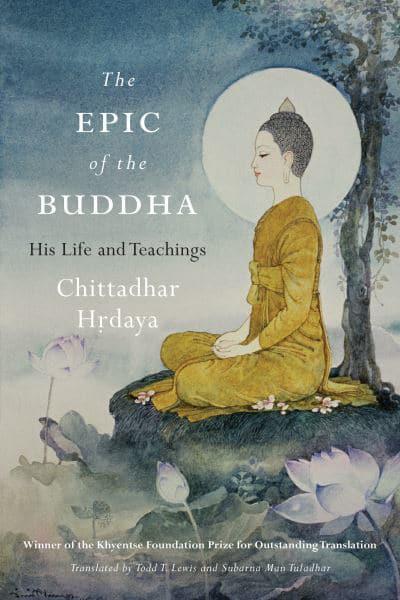Review of ''The Epic of the Buddha''

The Epic of the Buddha book cover
Chittadhar Hrdaya
Sugata Saurabha is an epic poem in the Newari language of the Kathmandhu Valley also known as Nepal Bhasa by Chittadhar Hrdaya (1906 – 1982) one of the greatest literary figures from Nepal in the 20th century. Sugata Saurabha, meaning “The Fragrant Life of the Buddha”, is a re-telling of the life story of Gautama Buddha.
Chittadhar Hrdaya was imprisoned for writing in the officially suppressed Newari language in 1941. In his five years in prison he was denied access to writing materials. Somehow, he managed to scribble on scraps of paper what turned out to be one of the great literary masterpieces of the forbidden language.
On his release the work was eventually published in Calcutta in India. As the suppression of Newari culture was relaxed in the following decades his reputation and acceptance as writer and literary and cultural figure grew. After his death he was commemorated with a statue on a traffic roundabout, which must count as a measure of literary greatness.
The number of people able to enjoy this work in its original Newari is somewhat limited, not just by the relatively few native speakers of the language but also due to its highly poetic and scholarly nature. He borrows heavily in his vocabulary from Sanskrit, as befits a work steeped in Mahayana orthodoxy. Sanskrit was always a language of the scholarly elite, full of clever puns and knowing allusions that makes it a true challenge for translators. Wisely in this case the translators have opted for a more literal than a poetical translation in line with the adage that “good prose is better than bad poetry”. There is poetry enough in the original. If poetry is defined as that which is lost in translation, what has been lost must be immense. What we have is a powerful, sweeping epic that brings alive the world of the Buddha. It is not so much a retelling as a vivid re-imagining of the Buddha’s life story, transposed to the poet’s familiar world of the Kathmandu valley. At times one is reminded of nothing so much as James Joyce’s reliving of the wanderings of Ulysses around the streets of Dublin. I was also reminded of Stanley Spencer’s very moving depictions of Christ participating in the rituals of life in his native Thameside village. The Epic of the Buddha is full of vivid descriptions of nature, every flower, tree, insect is described in affectionate detail. Sensuous descriptions borrowed from Sanskrit love poetry are worked into the text to describe Prince Gautama’s life before the Great Renunciation; this story evokes the complete emotional register. The death of the Buddha’s mother queen Maya and king Suddhodana’s grief is told in truly affecting detail. I had to skip ahead to make sure that the story of Kisagotami was not to follow too soon or I would not have made it!
After the Renunciation we track the Buddha all the way to his Parinirvana. Although we might know the stories presented from pervious reading, especially from the Dhammapada, what we have here is them retold by a master storyteller who drives us on like the narrator of a page-turning thriller.
If I had to find fault, I would say it is a pity that a few verses were not given in a transliteration of the Newari for us to be able to hear some semblance of the original. The illustrations are miniature black and white copies of the originals that appeared in colour in the original version published in Calcutta. One gets a sense of a vividly detailed world that would have been a joy to explore in more faithful copies.
Balanced against that however there are some excellent “Additional Features” in appendices at the end of the book. Much of the scholarship, borne so lightly in the translation of the text, is given room in the last few chapters where historical context, Buddhist scriptural underpinnings, the linguistic milieu of the author and the pains of translation are all dealt with.
This book is a treasure. I look forward to learning more about its author and his culture as I continue my reading. We can be grateful that the translators have delivered this beautiful telling of the life of the Buddha for us to enjoy and contemplate.
The Epic of the Buddha: His Life and Teachings Chittadhar Hrdaya Shambala, 2019, ISBN 978-1-61180-619-9. Translated by Lewis, Todd T., and Tuladhar, Subarna Man
Publication date: 21st May 2019
Review by Michael O’Neill
…………………………………….





